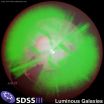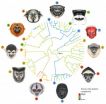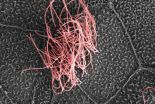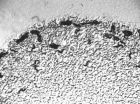(Press-News.org) Since 2000, the three Sloan Digital Sky Surveys (SDSS I, II, III) have surveyed well over a quarter of the night sky and produced the biggest color map of the universe in three dimensions ever. Now scientists at the U.S. Department of Energy's Lawrence Berkeley National Laboratory (Berkeley Lab) and their SDSS colleagues, working with DOE's National Energy Research Scientific Computing Center (NERSC) based at Berkeley Lab, have used this visual information for the most accurate calculation yet of how matter clumps together – from a time when the universe was only half its present age until now.
"The way galaxies cluster together over vast expanses of the sky tells us how both ordinary visible matter and underlying invisible dark matter are distributed, across space and back in time," says Shirley Ho, an astrophysicist at Berkeley Lab and Carnegie Mellon University, who led the work. "The distribution gives us cosmic rulers to measure how the universe has expanded, and a basis for calculating what's in it: how much dark matter, how much dark energy, even the mass of the hard-to-see neutrinos it contains. What's left over is the ordinary matter and energy we're familiar with."
For the present study Ho and her colleagues first selected 900,000 luminous galaxies from among over 1.5 million such galaxies gathered by the Baryon Oscillation Spectrographic Survey, or BOSS, the largest component of the still-ongoing SDSS III. Most of these are ancient red galaxies, which contain only red stars because all their faster-burning stars are long gone, and which are exceptionally bright and visible at great distances. The galaxies chosen for this study populate the largest volume of space ever used for galaxy clustering measurements. Their brightness was measured in five different colors, allowing the redshift of each to be estimated.
"By covering such a large area of sky and working at such large distances, these measurements are able to probe the clustering of galaxies on incredibly vast scales, giving us unprecedented constraints on the expansion history, contents, and evolution of the universe," says Martin White of Berkeley Lab's Physics Division, a professor of physics and astronomy at the University of California at Berkeley and chair of the BOSS science survey teams. "The clustering we're now measuring on the largest scales also contains vital information about the origin of the structure we see in our maps, all the way back to the epoch of inflation, and it helps us to constrain – or rule out – models of the very early universe."
After augmenting their study with information from other data sets, the team derived a number of such cosmological constraints, measurements of the universe's contents based on different cosmological models. Among the results: in the most widely accepted model, the researchers found – to less than two percent uncertainty – that dark energy accounts for 73 percent of the density of the universe.
The team's results are presented January 11 at the annual meeting of the American Astronomical Society in Austin, Texas, and have been submitted to the Astrophysical Journal. They are currently available online at http://arxiv.org/abs/1201.2137.
The power of the universe
"The way mass clusters on the largest scales is graphed in an angular power spectrum, which shows how matter statistically varies in density across the sky," says Ho. "The power spectrum gives a wealth of information, much of which is yet to be exploited." For example, information about inflation – how the universe rapidly expanded shortly after the big bang – can be derived from the power spectrum.
Closely related to the power spectrum are two "standard rulers," which can be used to measure the history of the expansion of the universe. One ruler has only a single mark – the time when matter and radiation were exactly equal in density.
"In the very early universe, shortly after the big bang, the universe was hot and dominated by photons, the fundamental particles of radiation," Ho explains. "But as it expanded, it began the transition to a universe dominated by matter. By about 50,000 years after the big bang, the density of matter and radiation were equal. Only when matter dominated could structure form."
The other cosmic ruler is also big, but it has many more than one mark in the power spectrum; this ruler is called BAO, for baryon acoustic oscillations. (Here, baryon is shorthand for ordinary matter.) Baryon acoustic oscillations are relics of the sound waves that traveled through the early universe when it was a hot, liquid-like soup of matter and photons. After about 50,000 years the matter began to dominate, and by about 300,000 years after the big bang the soup was finally cool enough for matter and light to go their separate ways.
Differences in density that the sound waves had created in the hot soup, however, left their signatures as statistical variations in the distribution of light, detectable as temperature variations in the cosmic microwave background (CMB), and in the distribution of baryons. The CMB is a kind of snapshot that can still be read today, almost 14 billion years later. Baryon oscillations – variations in galactic density peaking every 450 million light-years or so – descend directly from these fluctuations in the density of the early universe.
BAO is the target of the Baryon Oscillation Spectroscopic Survey. By the time it's completed, BOSS will have measured the individual spectra of 1.5 million galaxies, a highly precise way of measuring their redshifts. The first BOSS spectroscopic results are expected to be announced early in 2012.
Meanwhile the photometric study by Ho and her colleagues deliberately uses many of the same luminous galaxies but derives redshifts from their brightnesses in different colors, extending the BAO ruler back over a previously inaccessible redshift range, from z = 0.45 to z = 0.65 (z stands for redshift).
"As an oscillatory feature in the power spectrum, not many things can corrupt or confuse BAO, which is why it is considered one of the most trustworthy ways to measure dark energy," says Hee-Jong Seo of the Berkeley Center for Cosmological Physics at Berkeley Lab and the UC Berkeley Department of Physics, who led BAO measurement for the project. "We call BAO a standard ruler for a good reason. As dark energy stretches the universe against the gravity of dark matter, more dark energy places galaxies at a larger distance from us, and the BAO imprinted in their distribution looks smaller. As a standard ruler the true size of BAO is fixed, however. Thus the apparent size of BAO gives us an estimate of the cosmological distance to our target galaxies – which in turn depends on the properties of dark energy."
Says Ho, "Our study has produced the most precise photometric measurement of BAO. Using data from the newly accessible redshift range, we have traced these wiggles back to when the universe was about half its present age, all the way back to z = 0.54."
Seo adds, "And that's to an accuracy within 4.5 percent."
Reining in the systematics
"With such a large volume of the universe forming the basis of our study, precision cosmology was only possible if we could control for large-scale systematics," says Ho. Systematic errors are those with a physical basis, including differences in the brightness of the sky, or stars that mimic the colors of distant galaxies, or variations in weather affecting "seeing" at the SDSS's Sloan Telescope – a dedicated 2.5 meter telescope at the Apache Point Observatory in southern New Mexico.
After applying individual corrections to these and other systematics, the team cross-correlated the effects on the data and developed a novel procedure for deriving the best angular power-spectrum of the universe with the lowest statistical and systematic errors.
With the help of 40,000 central-processing-unit (CPU) hours at NERSC and another 20,000 CPU hours on the Riemann computer cluster at Berkeley Lab, NERSC's powerful computers and algorithms enabled the team to use all the information from galactic clustering in a huge volume of sky, including the full shape of the power spectrum and, independently, BAO, to get excellent cosmological constraints. The data as well as the analysis output are stored at NERSC.
"Our dataset is purely imaging data, but our results are competitive with the latest large-scale spectroscopic surveys," Ho says. "What we lack in redshift precision, we make up in sheer volume. This is good news for future imaging surveys like the Dark Energy Survey and the Large Synoptic Survey Telescope, suggesting they can achieve significant cosmological constraints even compared to future spectroscopy surveys."
INFORMATION:
Animated visualizations of the luminous galaxies in the SDSS-III dataset can be accessed at http://darkmatter.ps.uci.edu/lrg-sdss.
"Clustering of Sloan Digital Sky Survey III photometric luminous galaxies: The measurement, systematics, and cosmological implications," by Shirley Ho, Antonio Cuesta, Hee-Jong Seo, Roland de Putter, Ashley J. Ross, Martin White, Nikhil Padmanabhan, Shun Saito, David J. Schlegel, Eddie Schlafly, Uroŝ Seljak, Carlos Hernández-Monteagudo, Ariel G. Sánchez, Will J. Percival, Michael Blanton, Ramin Skibba, Don Schneider, Beth Reid, Olga Mena, Matteo Viel, Daniel J. Eisenstein, Francisco Prada, Benjamin Weaver, Neta Bahcall, Dimitry Bizyaev, Howard Brewinton, Jon Brinkman, Luiz Nicolaci da Costa, John R. Gott, Elena Malanushenko, Viktor Malanushenko, Bob Nichol, Daniel Oravetz, Kaike Pan, Nathalie Palanque-Delabrouille, Nicholas P. Ross, Audrey Simmons, Fernando de Simoni, Stephanie Snedden,and Christophe Yeche, has been submitted to Astrophysical Journal and is now available online at http://arxiv.org/abs/1201.2137.
"Acoustic scale from the angular power spectra of SDSS-III DR8 photometric luminous galaxies," by Hee-Jong Seo, Shirley Ho, Martin White, Antonio Cuesta, Ashley Ross, Shun Saito, Beth Reid, Nikhil Padmanabhan, Will J. Percival, Roland de Putter, David Schlegel, Daniel Eisenstein, Xiaoying Xu, Donald Schneider, Ramin Skibba, Licia Verde, Robert Nichol, Dmitry Bizyaev, Howard Brewington, J. Brinkmann, Luiz Costa, J. Gott III, Elena Malanushenko, Viktor Malanushenko, Dan Oravetz, Nathalie Palanque-Delabrouille, Kaike Pan, Francisco Prada, Nicholas Ross, Audrey Simmons, Fernando Simoni, Alaina Shelden, Stephanie Snedden, and Idit Zehavi, has been submitted to Astrophysical Journal and will be available online shortly.
Funding for SDSS-III has been provided by the Alfred P. Sloan Foundation, the Participating Institutions, the National Science Foundation, and the U.S. Department of Energy's Office of Science. The SDSS-III web site is http://www.sdss3.org/.
SDSS-III is managed by the Astrophysical Research Consortium for the Participating Institutions of the SDSS-III Collaboration including the University of Arizona, the Brazilian Participation Group, Brookhaven National Laboratory, University of Cambridge, Carnegie Mellon University, University of Florida, the French Participation Group, the German Participation Group, the Instituto de Astrofisica de Canarias, the Michigan State/Notre Dame/JINA Participation Group, Johns Hopkins University, Lawrence Berkeley National Laboratory, Max Planck Institute for Astrophysics, New Mexico State University, New York University, Ohio State University, Pennsylvania State University, University of Portsmouth, Princeton University, the Spanish Participation Group, University of Tokyo, University of Utah, Vanderbilt University, University of Virginia, University of Washington, and Yale University.
DOE's Office of Science is the single largest supporter of basic research in the physical sciences in the United States, and is working to address some of the most pressing challenges of our time. For more information, please visit the Office of Science website at http://science.energy.gov/.
Lawrence Berkeley National Laboratory addresses the world's most urgent scientific challenges by advancing sustainable energy, protecting human health, creating new materials, and revealing the origin and fate of the universe. Founded in 1931, Berkeley Lab's scientific expertise has been recognized with 13 Nobel prizes. The University of California manages Berkeley Lab for the U.S. Department of Energy's Office of Science. For more, visit www.lbl.gov.
Scientific contact: Shirley Ho, cwho@lbl.gov
Calculating what's in the universe from the biggest color 3-D map
Berkeley Lab scientists and their Sloan Digital Sky Survey colleagues use galactic brightness to build a precision model of the cosmos
2012-01-13
ELSE PRESS RELEASES FROM THIS DATE:
Stenting for stroke prevention becoming safer in high-risk patients
2012-01-13
MADISON –Placing a stent in a key artery in the neck is safer than ever in patients ineligible for the standard surgical treatment of carotid artery disease, according to a new study published online today in the Journal of Vascular Surgery.
A team of researchers led by Dr. Jon Matsumura, head of the vascular surgery division at University of Wisconsin School of Medicine and Public Health, found the clinical trial PROTECT (Carotid Artery Stenting with Distal Embolic Protection with Improved System) had the lowest rate of complications ever in patients considered high ...
Evolution is written all over your face
2012-01-13
Why are the faces of primates so dramatically different from one another?
UCLA biologists working as "evolutionary detectives" studied the faces of 129 adult male primates from Central and South America, and they offer some answers in research published today, Jan. 11, in the early online edition of the journal Proceedings of the Royal Society B. The faces they studied evolved over at least 24 million years, they report.
"If you look at New World primates, you're immediately struck by the rich diversity of faces," said Michael Alfaro, a UCLA associate professor ...
UMass Amherst chemical engineers boost petrochemical output from biomass by 40 percent
2012-01-13
AMHERST, Mass. – Chemical engineers at the University of Massachusetts Amherst, using a catalytic fast pyrolysis process that transforms renewable non-food biomass into petrochemicals, have developed a new catalyst that boosts the yield for five key "building blocks of the chemical industry" by 40 percent compared to previous methods. This sustainable production process, which holds the promise of being competitive and compatible with the current petroleum refinery infrastructure, has been tested and proven in a laboratory reactor, using wood as the feedstock, the research ...
Hubble breaks new ground with discovery of distant exploding star
2012-01-13
NASA's Hubble Space Telescope has looked deep into the distant universe and detected the feeble glow of a star that exploded more than 9 billion years ago. The sighting is the first finding of an ambitious survey that will help astronomers place better constraints on the nature of dark energy, the mysterious repulsive force that is causing the universe to fly apart ever faster.
"For decades, astronomers have harnessed the power of Hubble to unravel the mysteries of the universe," said John Grunsfeld, associate administrator for NASA's Science Mission Directorate in Washington. ...
LSU professor discovers world's tiniest vertebrate
2012-01-13
BATON ROUGE – LSU's Chris Austin recently discovered two new species of frogs in New Guinea, one of which is now the world's tiniest known vertebrate, averaging only 7.7 millimeters in size – less than one-third of an inch. It ousts Paedocypris progenetica, an Indonesian fish averaging more than 8 millimeters, from the record. Austin, leading a team of scientists from the United States including LSU graduate student Eric Rittmeyer, made the discovery during a three-month long expedition to the island of New Guinea, the world's largest and tallest tropical island.
"It ...
New species of tiny frog is world's smallest vertebrate
2012-01-13
Researchers have found two new frog species in New Guinea, one of which is the new smallest known vertebrate on Earth. The results are reported in the Jan. 11 issue of the online journal PLoS ONE, and the team of researchers was led by Christopher Austin of Louisiana State University.
The new smallest vertebrate species is called Paedophryne amauensis, named after Amau Village in Papua New Guinea, where it was found. The adult body size for these frogs ranges from just 7.0 to 8.0 millimeters.
According to Dr. Austin, the discovery "is of considerable interest to biologists ...
Selectively stopping glutathione sensitizes brain tumors to chemotherapy
2012-01-13
Brain cancer cells are particularly resistant to chemotherapy — toxins enter the cells, but before the toxins can kill, cancer cells quickly pump them back outside. In fact, brain cancer cells are even better than healthy cells at cleaning themselves. This means that when hit with chemotherapy, healthy cells tend to die before brain cancer cells. Especially in the brain, killing healthy cells is bad.
Researchers at the University of Colorado Cancer Center have discovered a way to turn off the pumps — only in brain cancer cells and not in their healthy neighbors. Promising ...
Diet counts: Iron intake in teen years can impact brain in later life
2012-01-13
Iron is a popular topic in health news. Doctors prescribe it for medical reasons, and it's available over the counter as a dietary supplement. And while it's known that too little iron can result in cognitive problems, it's also known that too much promotes neurodegenerative diseases.
Now, researchers at UCLA have found that in addition to causing cognitive problems, a lack of iron early in life can affect the brain's physical structure as well.
UCLA neurology professor Paul Thompson and his colleagues measured levels of transferrin, a protein that transports iron ...
Scientists identify gene crucial to normal development of lungs and brain
2012-01-13
La Jolla ---- Scientists at the Salk Institute for Biological Studies have identified a gene that tells cells to develop multiple cilia, tiny hair-like structures that move fluids through the lungs and brain. The finding may help scientists generate new therapies that use stem cells to replace damaged tissues in the lung and other organs.
"Cells with multiple cilia play a number of important roles, including moving fluids through the respiratory tract, brain and spinal cord," says Christopher R. Kintner, a professor in Salk's Molecular Neurobiology Laboratory, who led ...
Worm seeks worm: Caltech researchers find chemical cues driving aggregation in nematodes
2012-01-13
PASADENA, Calif.— Scientists have long seen evidence of social behavior among many species of animals, both on the earth and in the sea. Dolphins frolic together, lions live in packs, and hornets construct nests that can house a large number of the insects. And, right under our feet, it appears that nematodes—also known as roundworms—are having their own little gatherings in the soil. Until recently, it was unknown how the worms communicate to one another when it's time to come together. Now, however, researchers from the California Institute of Technology (Caltech) and ...
LAST 30 PRESS RELEASES:
Tracing the quick synthesis of an industrially important catalyst
New software sheds light on cancer’s hidden genetic networks
UT Health San Antonio awarded $3 million in CPRIT grants to bolster cancer research and prevention efforts in South Texas
Third symposium spotlights global challenge of new contaminants in China’s fight against pollution
From straw to soil harmony: International team reveals how biochar supercharges carbon-smart farming
Myeloma: How AI is redrawing the map of cancer care
Manhattan E. Charurat, Ph.D., MHS invested as the Homer and Martha Gudelsky Distinguished Professor in Medicine at the University of Maryland School of Medicine
Insilico Medicine’s Pharma.AI Q4 Winter Launch Recap: Revolutionizing drug discovery with cutting-edge AI innovations, accelerating the path to pharmaceutical superintelligence
Nanoplastics have diet-dependent impacts on digestive system health
Brain neuron death occurs throughout life and increases with age, a natural human protein drug may halt neuron death in Alzheimer’s disease
SPIE and CLP announce the recipients of the 2025 Advanced Photonics Young Innovator Award
Lessons from the Caldor Fire’s Christmas Valley ‘Miracle’
Ant societies rose by trading individual protection for collective power
Research reveals how ancient viral DNA shapes early embryonic development
A molecular gatekeeper that controls protein synthesis
New ‘cloaking device’ concept to shield sensitive tech from magnetic fields
Researchers show impact of mountain building and climate change on alpine biodiversity
Study models the transition from Neanderthals to modern humans in Europe
University of Phoenix College of Doctoral Studies releases white paper on AI-driven skilling to reduce burnout and restore worker autonomy
AIs fail at the game of visual “telephone”
The levers for a sustainable food system
Potential changes in US homelessness by ending federal support for housing first programs
Vulnerability of large language models to prompt injection when providing medical advice
Researchers develop new system for high-energy-density, long-life, multi-electron transfer bromine-based flow batteries
Ending federal support for housing first programs could increase U.S. homelessness by 5% in one year, new JAMA study finds
New research uncovers molecular ‘safety switch’ shielding cancers from immune attack
Bacteria resisting viral infection can still sink carbon to ocean floor
Younger biological age may increase depression risk in older women during COVID-19
Bharat Innovates 2026 National Basecamp Showcases India’s Most Promising Deep-Tech Ventures
Here’s what determines whether your income level rises or falls
[Press-News.org] Calculating what's in the universe from the biggest color 3-D mapBerkeley Lab scientists and their Sloan Digital Sky Survey colleagues use galactic brightness to build a precision model of the cosmos




